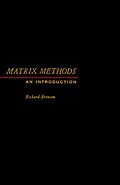Matrix Methods: An Introduction is a nine-chapter text that emphasizes the methodological aspects of mathematical matrices. This book is intended for an introductory course in matrices similar to those given to sophomore and junior engineering students at Fairleigh Dickinson University.
The first five chapters deal with the elementary aspects of matrices, including their definition, determinants, method of inversion, simultaneous linear equations, eigenvalues, and eigenvectors. The remaining chapters explore the materials of fundamental importance to both engineers and scientists. These chapters discuss the principles of matrix calculus, linear differential equations, Jordan canonical forms, and special matrices. A set of exercises is provided at the end of each section, which is basically routine in nature and serves primarily to enhance the reader's ability to use the methods just presented. On occasion, problems are assigned that will extend or complete topics previously introduced.
This book is intended primarily for science, engineering, and applied mathematics students.
Autorentext
Richard Bronson has written several books and numerous articles on Mathematics. He has served as Interim Provost of the Metropolitan Campus, and has been Acting Dean of the College of Science and Engineering at the university in New Jersey.
Inhalt
Preface
Acknowledgments
1. Matrices
1.1 Matrices
1.2 Operations
1.3 Matrix Multiplication-I
1.4 Matrix Multiplication-II
1.5 Special Matrices
1.6 Submatrices and Partitioning
1.7 Vectors
2. Determinants
2.1 Determinants
2.2 Expansion by Cofactors
2.3 Properties of Determinants
2.4 Pivotal Condensation
2.5 Cramer's Rule
3. The Inverse
3.1 The Inverse
3.2 Simultaneous Equations
3.3 Properties of the Inverse
3.4 Another Method for Inversion
Appendix to Chapter 3
4. Simultaneous Linear Equations
4.1 Linear Systems
4.2 Solutions by Inversion
4.3 Gaussian Elimination
4.4 Linear Independence
4.5 Rank
4.6 Theory of Solutions
4.7 Matrix Solutions
4.8 Homogeneous Systems
5. Eigenvalues and Eigenvectors
5.1 Definitions
5.2 Eigenvalues
5.3 Eigenvector
5.4 Properties of Eigenvalues and Eigenvectors
5.5 Linearly Independent Eigenvectors
6. Matrix Calculus
6.1 Definitions
6.2 Cayley-Hamilton Theorem
6.3 Polynomials of Matrices-Distinct Eigenvalues
6.4 Polynomials of Matrices-General Case
6.5 Functions of a Matrix
6.6 The Function eAt
6.7 Complex Eigenvalues
6.8 Properties of eA
6.9 Derivatives of a Matrix
Appendix to Chapter 6
7. Linear Differential Equations
7.1 Fundamental Form
7.2 Reduction of an nth Order Equation
7.3 Reduction of a System
7.4 Solutions of Systems with Constant Coefficients
7.5 Examples
7.6 Solutions of Systems-General Case
7.7 Properties of the Transition Matrix
7.8 The Adjoint System
Appendix to Chapter 7
8. Jordan Canonical Forms
8.1 Similar Matrices
8.2 Diagonalizable Matrices
8.3 Functions of Matrices-Diagonalizable Matrices
8.4 Generalized Eigenvectors
8.5 Chains
8.6 Canonical Basis
8.7 Jordan Canonical Forms
8.8 Functions of Matrices-General Case
8.9 The Function eAt
Appendix to Chapter 8
9. Special Matrices
9.1 Introduction
9.2 Inner Products
9.3 Orthonormal Vectors
9.4 Self-Adjoint Matrices
9.5 Real Symmetric Matrices
9.6 Orthogonal Matrices
9.7 Hermitian Matrices
9.8 Unitary Matrices
9.9 Summary
9.10 Positive Definite Matrices
Answers and Hints to Selected Problems
References
Index
